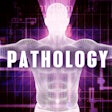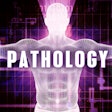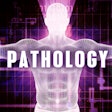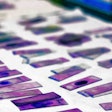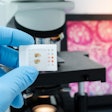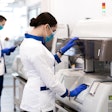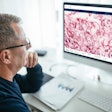
LOS ANGELES - At the start of the COVID-19 pandemic, pathology labs struggled to maintain service in the face of lockdowns and staffing problems. However, the pandemic had a silver lining: It catalyzed and accelerated broad global adoption of digital pathology, according to a presentation at the United States and Canadian Academy of Pathology (USCAP) meeting.
During the presentation, Dr. Liron Pantanowitz, a professor of pathology and the director of anatomic pathology at the University of Michigan, offered a glimpse into the future of pathology -- both at work and in teaching -- once the pandemic has passed.
A dip in workload -- followed by a rebound
As pathology labs around the world struggled to maintain service at the start of the pandemic, mainly due to staffing problems, they at least had the benefit of the precipitous drop in workload caused by the pandemic.
"In the beginning, we were lucky because the workload dropped because people weren't getting biopsies or major surgeries," Pantanowitz said.
On the other hand, the number of autopsies began to increase as patients began to die -- both from COVID and non-COVID-related causes.
"For example, we saw people who had a burst appendix but were too scared to come to the hospital because they thought they're going to get COVID, so they ended up with sepsis and died," Pantanowitz said.
Later, as the worst of the pandemic receded, the pathology workload began to increase dramatically, Pantanowitz noted.
"There are too many specimens, and the workforce cannot match the workload now," he said. "It means we need to be creative, and digital technology certainly can do that. Basically, we now realize that digital pathology provides that flexibility that we need."
Is pathology really ready to go digital?
The pandemic highlighted the lack of readiness of many analog-based pathology departments to go digital, according to Pantanowitz. Many of the pathology labs eager to implement remote digital reporting found themselves stymied by inflexible IT systems, slow-moving processes for information governance, and slide scanners that still needed to be validated for clinical work.
"It was a shock to the pathology world that we were not ready even though we had all the technology," Pantanowitz said. "There were technical hurdles. Can we replicate the workstation at home? Can we give them remote access to their workstation through a VPN [virtual private network] or other means?"
However, it soon became clear that workstation access was not enough, Pantanowitz said -- the entire pathology workflow needed to be looked at.
"It's not just the connection to the slide, or the whole-slide image. They need a connection to the information system if they're going to look up the case and report it out," Pantanowitz said. "And if they have to understand the clinical context, they need access to the [electronic medical record] as well. You had to develop policies on how to do all this, which people did, amazingly. And the truth is, it worked."
Pathology rises to the challenge
Pantanowitz cited a number of validation studies on remote pathology work that demonstrated that the digital results reported from remote sites exhibited high concordance to glass slide reads.
Pantanowitz also praised the College of American Pathologists for quickly establishing a practical FAQ website to respond to the myriad questions that arose about remote work, including the role of IT, validation, regulatory compliance, privacy, and billing.
He also cited the Point-of-Use Quality Assurance (POUQA) tool, developed at the University of Leeds in the U.K., which pathologists can use to ensure their display device allows them to see the minimum amount of visual contrast between colors for scoring digital pathology slides.
"The pathology community was very innovative," Pantanowitz said.
By rising to the challenge of the COVID pandemic, the community was able to remove the barriers to digital pathology -- not only among the regulators and manufacturers but also ordinary pathologists, whose mindset shifted from reluctance to a willingness to embrace digital pathology, Pantanowitz concluded.
"Digital pathology came to the rescue and allowed people to work from home and to teach virtually," he said. "That's the silver lining -- the good thing about COVID is that it has accelerated and catalyzed the adoption of digital pathology for all the use cases that it was designed for."












